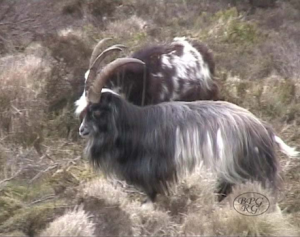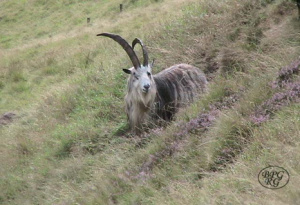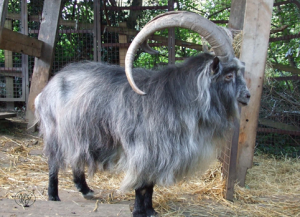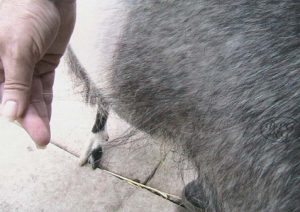We have invoked the term British Primitive Goat to avoid confusion and to encompass what has previously been known as the Old English/Scottish/Welsh/Irish, British Landrace or Old British Goat since these animals, as they were historically described, are very similar to each other and it is highly likely that they were part of the same landrace breed. This brings together the so called ‘varieties’ of our native goat under one umbrella. Of course in respect of the Irish goats only those in Northern Ireland can be considered under the British umbrella and those in Ireland continue to be called Old Irish; nevertheless we believe them to essentially be part of the same landrace group.
Importantly, we also use ‘British Primitive’ to clearly delineate and avoid confusion with other modern day goats referred to as ‘British’, ‘English’ and ‘Old English’. ‘British’ was used by the British Goat Society in the early days of dairy goat improvement to refer to crosses of foreign imports with existing British stock while those today labelled as ‘English’ or ‘Old English’ are modern recreations from a variety of sources to emulate earlier types of domesticated goats. The British Primitive Goat is the original and only unimproved goat breed of the British Isles; all our other breeds are based on comparatively recent imports or crosses arising from these. This hardy, landrace type has existed in Britain for thousands of years being kept as a multi-purpose animal invaluable for its milk, meat, skin, hair and tallow. British Primitive Goats were kept by the first farmers and the builders of Stonehenge. They sustained the people of the Bronze and Iron Ages alongside a few cattle and sheep, changed hands constantly during the Anglo-Saxon invasion and Viking raiding, were the herding goat of the Mediaeval manor and the mainstay of the early Cheddar Cheese industry. As such they are part of our culture and heritage and yet today the breed has lost favour, its value scarcely recognised.
Goats are generally accepted to have been brought from Persia by Neolithic Man c.3,000 BC while there was still a land bridge between Britain and the continent and feral herds may have become established from time to time ever since due to goats’ capricious nature and their tendency to escape. Kept as a multi-purpose animal by subsistence farmers and having to find most of its living in a harsh climate, these early imports developed into a hardy all-weather breed, self-sufficient on marginal land and able to convert nutritionally poor herbage into useful products for its owners. It has been shaped largely by its environment and so can be regarded as a primitive breed in the sense that it has not been selectively or intensively bred for certain characteristics according to man’s preferences.
As agricultural practices changed the goat became less and less popular. In the 1870s a Victorian goat revival began and promoted goats as ‘the poor man’s cow’ culminating in the founding of the British Goat Society in 1879. By then nobody was interested in our old British breed; they were simply too small, hairy and inconveniently horned. Modern aspirations were for a big high yielding goat with a smooth coat and no horns. Hence foreign breeds were introduced from India, the Middle East and Switzerland and the British Primitive Goat gradually died out in domestication from the late 1800s onwards as breeding for ‘improved’ goat stock and an ideal dairy goat began and our current breeds of Anglo Nubian, British Toggenberg, British Saanen and British Alpine were created. The last known true ‘Old English’ goats (i.e. British Primitives) kept in domestication died in 1953. Fortunately some British Primitives already existed in long standing feral herds due to the attendant difficulties of keeping them enclosed and with the intensification of farming and a breakdown of the sheiling system in Scotland. Others were deliberately released into the wild as the breed lost favour.
Two hundred years ago goats were widespread and common in Scotland and Northern England. Large culls have seen numbers drop dramatically and in some areas whole herds were eradicated. Other herds have been spoiled by introgression with modern breeds. Today British Primitive Goats are largely encountered as a feral/wild animal in herds in the Borders, Scotland and parts of Wales. Conflict with man’s economic interests still places many of the remaining herds under pressure and there is no legislation to protect them. Hence we are working with landowners and managers in several different parts of Britain to try and safeguard a gene pool of the remaining British Primitive stock and promote their use for conservation grazing and educational purposes as well as being an iconic breed in their own right.

(Above) Billy on Cairnsmore of Fleet, Galloway

(Above) Cheviot nanny and kid, relocated to a conservation project in Dumfries
Breed characteristics
The characteristics of the British Primitive Goat reflect its development and adaptation to intense cold and poor nutrition. It has compact conformation, relatively short legs, small ears, a thick coat with plenty of cashmere (underwool) and a large belly to cope with nutritionally poor forage. The concept of type is critical in ensuring good examples of the breed are preserved. It is the breed characteristics as a whole and the overall ‘giz’ of the goat that is important. Nevertheless, to try and give guidance relating to type, the details below have been formulated from much observation of many individuals across an array of wild herds plus some captive goats by Shirley Goodyer and Raymond Werner. Being a landrace breed there is likely to be a wider variation in characteristics than in, for example, modern show ring breeds. Nevertheless, we have found there to be a good conformity of type across several of the units of wild herds that we have observed. The correct type together with the history of a wild herd are important indicators as to where the best remaining examples of the British Primitive Goat may still be found. In due course no doubt DNA research will tell us more and help confirm what seems to be the case from phenotypic characteristics and historical documentation.
General conformation A deep bodied goat with a cobby appearance and legs generally not longer than depth of body (although note that some younger goats can go through a more ‘leggy’ developmental phase). Body length variable but proportionately shorter than in dairy breeds. Neck length also variable but generally thick set and relatively short compared to dairy breeds. Frequently ‘ewe-necked’. Breast bone prominent. Belly large and rounded with good capacity for coping with nutritionally poor forage. Slower to mature than modern breeds, continuing to grow and develop until 3-4 years of age.
Size Figures quoted in the early 1900s for English goats were equivalent to 60-68 cm at the shoulder and weight between 45-55 kg for males; for females, 55-60 cm and 32-45 kg. Size is partly genetic but also influenced by environmental conditions and availability of food. Our measurements on present day goats from the Cheviots and Galloway find similar results with adult males (3 years and over) to be up to 70 cm in height and weighing c.50-70 kg and adult females to be 60-65 cm, weighing c.35-60 kg (weights calculated from a calibration chart of girth dimensions against weight). Although claims for much larger, heavier males have been made for culled goats in parts of Scotland it is not clear whether these animals were of British Primitive type.
Head The head is neat and tapering to a relatively fine muzzle. It is not coarse or heavy. The forehead is broad with a prominent frontal bone giving a dip or stop where it meets the nasal bone. Hence the facial outline is slightly dished although as individuals age the facial outline may become straighter. In some older individuals we have also observed a slightly convex nasal bone outline with a convexity or small ‘bump’ that commences well below the level of the eyes (unlike e.g. the convexity that occurs in Anglo Nubians and Boer goats which originates much higher up the face).
Ears Small and habitually held pricked. Larger in females than males. In older males, ears may become more horizontal in carriage as a result of musculature changes in the neck to accommodate the weight of increasing horn size. The set and small size of the ears is quite distinctive from other goat breeds.


(Above) Male (left) and female (right) showing small pricked ears and horns with high angle of emergence from the head
Horns Present in both sexes. (Hornlessness could arguably arise by occasional mutation but as it is linked with an increased occurrence of hermaphoroditism/intersexes, and would in any case place a male feral goat at a disadvantage in the rut, it would be unlikely to persist. Polled goats are said to occur occasionally in some Scottish herds (Greig, 1969, ‘The Ecology of Feral Goats in Scotland’; MSc Thesis, Edinburgh)). However, where polled goats feature in feral herds other characteristics should be carefully evaluated as it is more likely to signify intermixing with e.g. modern Swiss breeds where polled individuals are much more common). Males have much larger and heavier horns than females, up to a metre long and a metre apart at the tip. They may be scimitar or with a dorcas twist. The angle of emergence from the head is always high. Scimitar horns may be a simple recurve or almost vertically upright with the ends turning backwards or slightly outwards. Dorcas horns grow upwards and then twist horizontally outwards at right angles to the line of the body, with the tips then turning upwards. The degree of twisting is never sufficient for the tips to be horizontal. Scimitar and dorcas horns are closely related and are more or less on a cline, with scimitar and dorcas forms being the extremes and some individuals showing more moderate twisting.
The horns of females are generally scimitar but may be twisted and curve slightly outwards; they are smaller and thinner than in the males.


(Above) Females – note small ears and horns with high angle of emergence from the head; heavy beard. One year old female on left is shorter coated but note the coat is still dense, shorter on the body but with longer fringing along the back and around the top of the legs.

(Above) Mature male with scimitar horns. Note high angle of emergence of the horns from the head, small ears, long coat and heavy beard blending with neck and chest hair.

Mature male showing horns with moderate twist. Note high angle of emergence of the horns from the head, small ears, long coat and heavy beard blending with neck and chest hair.
Tassels/Toggles Absent. Although there is perhaps no logical reason why they should not have the tassels present in many other goat breeds there is historically no documentation of them. In some feral herds we have observed individuals with tassels which is more likely to suggest intermixing with modern goat breeds such as Swiss or Pygmy goats than arising due to a spontaneous mutation. We have never observed them in the Cheviot goat.
Beard Always present and often heavy, particularly in males where it may blend into the long hair of the neck and chest.
Coat The coat type is a defining characteristic. Both relatively short coated and very long coated forms are found but the coat is always very thick and dense and never smooth and glossy. Short coated still means that in winter the body hair will generally be at least 10 cm long and very dense. Males generally display a longer coat than females with a significant beard that often blends with the neck and chest hair. If the coat is not long all over then a longer fringe along the back and ‘shaggy trousers’ are evident. Younger males notably have a forehead tuft of hair that may develop into quite a significant bouffant forelock or quiff until they are around 3 years old; the forehead hair then usually wanes as the horns increase in size, no doubt due to horn rubbing and sparring amongst males.
Females generally have a shorter coat than males but it is thick and dense with some fringing along the back and ‘shaggy trousers’.
The winter coat is thicker and denser than the summer coat in both sexes and there is an abundance of underwool or cashmere. The density of the cashmere is such that it tends to push the outer guard hairs upwards and outwards so that the goat tends to assume a very bulky appearance. On moulting, the density of the coat is such that some goats almost do a ‘peel’ as whole swathes of coat can be shed. Close observation of Cheviot goats has shown that as the new coat grows both guard hairs and cashmere come back in at the same time so the goats never really attain a sleek or glossy appearance and a cashmere covering can be found all year. This growth pattern persists even in goats that are stabled indicating it is a genetic feature and not solely down to environment. This is unlike many of our modern breeds which may display a small amount of cashmere in winter but then have a summer coat composed almost exclusively of guard hairs for a while before some cashmere develops again for the following winter.

Above and below: Coat of female Cheviot goat in summer a week after finishing moulting. Note remains of long guard hairs on the body which illustrates the depth of coat. Cashmere underwool already growing back in and this will bulk out to give a dense coat.



(Above) Male kid (left) and buckling (right) showing prominent forehead hair
Colour Coat colour is variable as common with a landrace breed. Colours may be whole or pied; various shades of grey and brown are the most prevalent. Very dark brown occurs but never a glossy black; where goats may appear black there will be faded brown fringing. Swiss patterning (white facial stripes, muzzle, lower legs and perineum and broadly white-rimmed ears – characteristics that are inherited as a package) never occurs and if found suggests introgression with modern Swiss breeds. Some wild herds have been isolated for some time and have often been culled back to low numbers, hence the prevalence of common colours and patterns may be somewhat different between herds.
Many of our modern goat breeds are defined by colour and pattern. In the case of identifying British Primitives, it is important to look beyond the colour and to overall conformation to check for appropriate breed type. Landrace breeds have a wider genetic base than modern, improved breeds. Each feral unit will have commenced with a limited number of animals likely to represent only part of the genetic gene pool available. Random breeding, natural selection and both unwitting and deliberate selection by man when culling will have shaped the herds of today. At one time goats in the Borders were able to intermix, with billies sometimes moving long distances between herds, but more fencing and increased isolation of units of goats have increasingly made this less likely.

© Copyright British Primitive Goat Research Group
